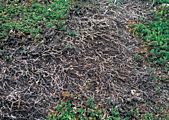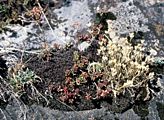Heat stress in alpine plants
It may sound paradoxical to discuss extreme heat effects in the alpine environment.
However, the combined effect of high solar radiation, slope inclination and exposure
plus poor plant cover on surface-dry substrate may indeed permit soil surface
temperatures of > 80 °C - high enough to kill most organisms on earth. Hence, for
short periods, heat can become a decisive survival criterion during plant recruitment
on bare ground in alpine regions.

1 -
Loiseleuria procumbens
Loiseleuria procumbens
can grow in very exposed places by forming dense carpets of only
1-2 cm thickness. Complete ground cover and intense transpiration
prevents tissue temperatures from rising above 35 °C. Mechanical
damage (e.g. by skiing or trampling) can open stands
and put them at great danger. Re-colonisation into damaged areas is
slow and by clonal propagation.
1 -
Broken stems caused by trampling have lost water supply, hence cannot
cool by transpiration, get hot and die.

2 -
Alpine desert
The mechanical damage to green ground cover removes evaporative
cooling and exposes dark brown humus to full solar radiation. Once
such surfaces are dry, heat can reach 80 °C, making seedling
establishment impossible. It takes a long time
to heal such wounds by clonal encroachment, provided erosion is not
faster.
2 -
Bare ground such as on this ski slope can heat to 80 °C under strong
insolation.

3 -
Climatic
hotspots in the Alpine
Thin layers of substrate on rocks dry out rapidly and heat may
reach the critical 52-56 °C range even in specialist plants.
Such microhabitats are commonly
occupied by mosses, lichens and algae (which are desiccation
tolerant), succulents (which can store water) and a few specialists
with either thin, vertical leaves (which are aerodynamically well
coupled to the atmosphere) or leaves of high reflectance, which
prevent overheating. All these life forms are shown on this
photograph with the succulent
Sedum alpestre
in the centre.
3 -
Specialists in dry, hot microhabitats: desiccating mosses, lichens
and succulents
(Sedum alpestre).
Dangerous situations in the Alpine are
- bare ground on equator facing slopes
- isolated seedlings in vegetation gaps
- rock communities
Alpine plants respond to this by
- rapid establishment of seedlings at the beginning of the season
- facilitation: seedlings establishing in the shelter of other plants
-
clonal propagation, growth into bare areas by
phalanx
mode
- high rates of transpiration (evaporative cooling)
-
total stand-still of life activity (in cryptogams; associated with desiccation)



